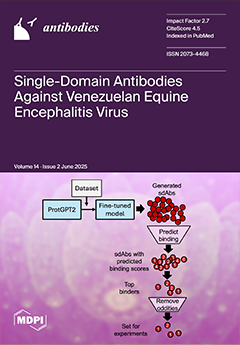Background: Monoclonal antibodies against the sodium-dependent phosphate transporter NaPi2b (
SLC34A2) represent a promising approach in the treatment of ovarian and lung cancer. Of particular interest is the potential cancer-specific MX35 epitope of NaPi2b, as it serves as a target for monoclonal
[...] Read more.
Background: Monoclonal antibodies against the sodium-dependent phosphate transporter NaPi2b (
SLC34A2) represent a promising approach in the treatment of ovarian and lung cancer. Of particular interest is the potential cancer-specific MX35 epitope of NaPi2b, as it serves as a target for monoclonal antibodies studied at various stages of preclinical and clinical trials. However, variations in the NaPi2b protein structure may limit the efficacy of therapeutic antibodies by affecting the accessibility of the MX35 epitope.
Methods: An in silico analysis was performed using data from 101,562 tumor samples. Genomic DNA sequencing was conducted on blood samples from patients with ovarian carcinoma, breast cancer, and renal carcinoma to access the frequency of germline mutations in the
SLC34A2 gene region encoding the MX35 epitope. To assess the impact of the selected mutation, we generated a model cell line through site-directed mutagenesis carrying the mutant NaPi2b variant.
Results: Using in silico analysis, we identified 17 unique variants in the
SLC34A2 gene leading to amino acid substitutions within the MX35 epitope of the NaPi2b. Among these, the most prevalent mutation, c.989C>T, resulting in p.T330M substitution, was detected in 5 out of 64 patients through genomic DNA sequencing. Using site-directed mutagenesis, we created the OVCAR-8/NaPi2b
p.T330M model cell line. L3 (28/1) monoclonal antibodies specific to the MX35 epitope failed to recognize the mutant NaPi2b
p.T330M variant compared to the wild-type of the NaPi2b in both Western blot and confocal microscopy experiments.
Conclusions: The obtained data may serve as a basis for predicting the efficacy of monoclonal antibody-based targeted therapy binding to the MX35 epitope of NaPi2b in the treatment of oncological diseases.
Full article






